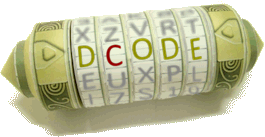Tool/Solver to solve crossword puzzles (or arrow words) from the letters already placed on the grid and the definitions.
Crossword Solver - dCode
Tag(s) : Word Games
dCode is free and its tools are a valuable help in games, maths, geocaching, puzzles and problems to solve every day!
A suggestion ? a feedback ? a bug ? an idea ? Write to dCode!
Crossword Solver
Find a Word with a pattern
Answers to Questions (FAQ)
What is a crossword? (Definition)
A crossword puzzle is a word and puzzle game that involves filling a grid with words that intersect horizontally and vertically.
Each word corresponds to a given definition and must fit with the other words using common letters.
The most popular variation is the arrow word puzzle, where the definitions are written directly in the grid squares.
What is a crossword solver? (Definition)
A crossword solver is a tool that helps find words matching a partially known pattern (e.g., missing letters).
It searches a dictionary for possible words based on the number of letters and the positions already filled, regardless of the given definition.
The dCode solver can also assist in designing crossword puzzles.
How to solve a crossword puzzle?
To solve a crossword puzzle using a solver, enter the known letters and replace the unknown letters with a wildcard symbol such as ?, -, ., _, *, or a space.
The solver then searches its database for all dictionary words matching this pattern.
Example: With 9 letters, D?F??I??O? gives DEFINITION or DEFOLIATOR
Most probable letters are displayed in percentages. Without finding the right word it is possible to fill some boxes.
Do not type the definition, but keep it in mind to compare it with the proposed words.
How to know the definitions of the words?
On dCode, to directly access the definition of a word, click on the proposed word, a tooltip containing the definition(s) of the word will appear.
Where to find a crossword dictionary?
How to indicate a hyphenated word?
dCode handles compound words as if it were not composed.
Example: TWENTY-ONE is interpreted as a 9-letter word: TWENTYONE
How to start crosswords/arrowords?
Here are some tips for getting started on a puzzle:
— Start with small words (2 to 4 letters), which are often recurring and easy to identify.
— Start toward the bottom right. This is where most words end, so there are many ending letters like E, S, R, or T.
— Identify the endings: a plural definition generally indicates an answer ending in S or X; a verbal definition calls for a verb conjugated in the same tense (with the same ending).
— Play a lot; experience will help you quickly recognize typical definitions and fill in the magazine puzzles more efficiently.
— Use the letters you've already found to complete the crossword puzzles using the dCode solver if necessary.
What do you call someone who likes to do crosswords?
An enthusiast who solves crosswords is called a crossworder.
A crossword author is called a cruciverbalist.
Source code
dCode retains ownership of the "Crossword Solver" source code. Any algorithm for the "Crossword Solver" algorithm, applet or snippet or script (converter, solver, encryption / decryption, encoding / decoding, ciphering / deciphering, breaker, translator), or any "Crossword Solver" functions (calculate, convert, solve, decrypt / encrypt, decipher / cipher, decode / encode, translate) written in any informatic language (Python, Java, PHP, C#, Javascript, Matlab, etc.) or any database download or API access for "Crossword Solver" or any other element are not public (except explicit open source licence). Same with the download for offline use on PC, mobile, tablet, iPhone or Android app.
Reminder: dCode is an educational and teaching resource, accessible online for free and for everyone.
Cite dCode
The content of the page "Crossword Solver" and its results may be freely copied and reused, including for commercial purposes, provided that dCode.fr is cited as the source (Creative Commons CC-BY free distribution license).
Exporting the results is free and can be done simply by clicking on the export icons ⤓ (.csv or .txt format) or ⧉ (copy and paste).
To cite dCode.fr on another website, use the link:
In a scientific article or book, the recommended bibliographic citation is: Crossword Solver on dCode.fr [online website], retrieved on 2025-12-22,
- Find a Word with a pattern
- What is a crossword? (Definition)
- What is a crossword solver? (Definition)
- How to solve a crossword puzzle?
- How to know the definitions of the words?
- Where to find a crossword dictionary?
- How to indicate a hyphenated word?
- How to start crosswords/arrowords?
- What do you call someone who likes to do crosswords?
